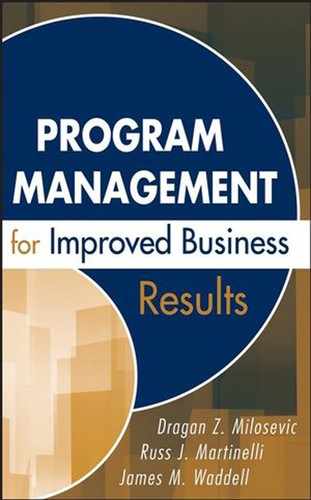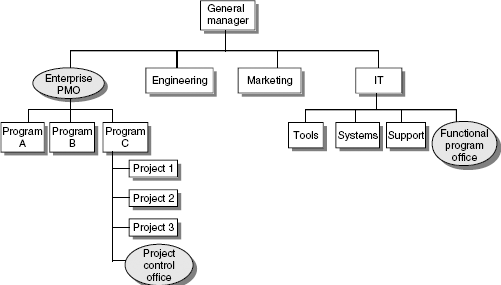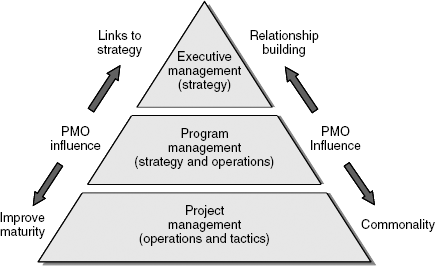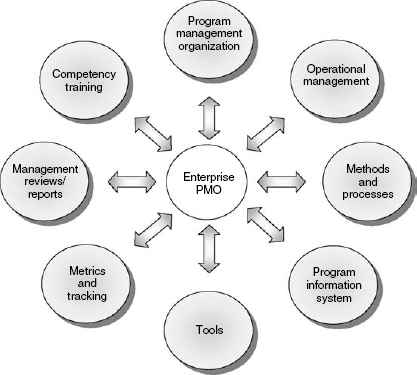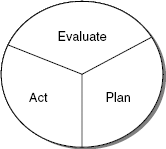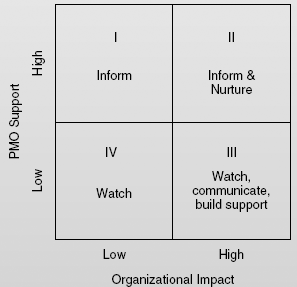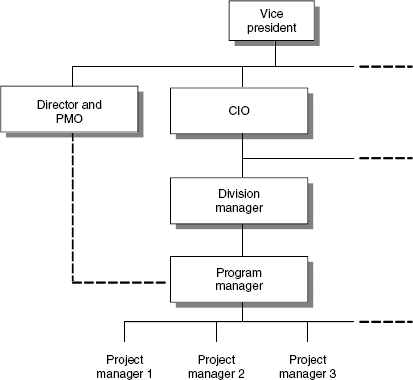As an organization grows in its implementation and maturity of the program management discipline, a natural progression that many firms follow is the formation of a program management office, or PMO. The PMO addresses two of the most common problems that arise as the use of program management increases within an organization. First is the realization of the need for consistency in the definition, planning, and execution of all programs within a business unit. Without consistency across the portfolio of programs, business results are not predictable or repeatable on a recurring basis. The second realization that arises is the need for a single program management point of contact within an organization. A single point of contact for program management provides improved communication, decision making, and program oversight.
The PMO provides leadership and infrastructure for managing and controlling multiple programs. It represents a compilation of program management infrastructure, support, tools, and best practices that have been melded together to improve business results and drive continual gains in a firm's management of its product, service, or infrastructure development efforts.
Roger Lundberg is a former PMO director of the Jeep division at DaimlerChrysler and currently the director of Chrysler development system and vehicle engineering operations. According to Lundberg,
"Successful implementation of program management within an organization requires a certain amount of infrastructure. Key elements of that infrastructure includes a good portfolio management process, a well-defined and executed development process, a good requirements system, and good processes such as resource management, change management, decision making, budgeting, scheduling, and financial target setting."
An effective PMO provides the right level of program management infrastructure and aligns it with the overall organizational culture and structure.
This chapter focuses on the role the PMO plays in establishing program management as a functional discipline within an organization. The description of the PMO, its primary functions, and operational elements are discussed. Additionally, PMO implementation guidelines and a variety of organizational factors that are worthy of consideration when a management team is evaluating the formation of a PMO are presented, as well as how a PMO contributes to improved business results. An example from an information technology organization is included at the end of this chapter to demonstrate the use of a PMO. Senior managers and practicing program managers will find the information contained in this chapter helpful in understanding the following:
Why companies have implemented PMOs
What constitutes a PMO
The functions and operational elements of an enterprise PMO
PMO implementation guidelines
So what is a program management office and how does it differ from the project management office?
The PMO is a centralized body within an organization that is responsible for instilling structured leadership, methodology, and infrastructure across all programs to make the best use of a company's time, money, and human resources (see the box titled, "PMO: A New Idea?"). The objective of the PMO is to promote and drive consistent, repeatable program management practices within an organization. It represents a compilation of product, service, or infrastructure development best practices that has been melded into an integrated approach that is targeted at improving business results. More specifically, it is a central function utilized for simultaneous management of multiple development programs.
The program management office differs from the more common, typical project management office in at least the following two ways:[166]
First, the PMO is focused on consistency of methods, tools, and practices across all programs within an organization, as well as consistency of methods, tools, and practices across all projects that make up a program. Therefore, the PMO encompasses both program and project management practices.
Second, the PMO is focused on business and strategic success. It's responsible for defining and measuring program metrics that measure business goals and ensuring that each program supports and helps to achieve the strategic objectives of the company.
PMOs are used across a wide array of organizations and industries for coordinating various types of programs. It can manifest itself in a wide spectrum of implementations ranging from an informal community of practice to a comprehensive, enterprise-level PMO. The appropriate implementation of the PMO is dependent upon the objectives, complexity, and culture of the specific firm. Normally, a formal PMO is more useful and cost effective for larger firms and is especially beneficial for companies with geographically distributed sites and teams. Large, decentralized firms; single-site organizations; or those with a limited number of product, service, or infrastructure development programs may not warrant the need for a comprehensive and formal PMO. For these organizations, it may be more appropriate to create an informal PMO in the form of a community of practice.
It is also important to point out what a PMO is not. It is not a cure-all for poor business strategy, and it will not substitute for comprehensive portfolio planning. Likewise, it is not a strategic planning function for a business unit or a company. Even though it can be formalized within the organization, its structure and use does not have to be rigid or inflexible. It often is not as effective in a decentralized organization, and it is not a panacea. It won't solve all the problems that exist within an organization.
The impetus for the creation of a PMO most often originates out of the need for continual improvement in achievement of business objectives caused by major change within the organization (see box titled, "Gaining Control Through the PMO"). This could be fueled by such things as a firm's rapid growth, mergers and acquisitions, or relocation of operations to multiple sites. Changes such as these may yield a greater number of programs; larger programs; increased complexity due to design and team structure; and codevelopment of new products, services, or infrastructure capabilities involving multiple geographical sites. These changes, although strategically important to the firm, may create challenges to achievement of business objectives because of inconsistency in program performance, poor communication between program managers and key stakeholders, variability in program measurement techniques, and the lack of central coordination of all programs within an organization.
These challenges become even greater as growth occurs internationally, adding language, cultural, and time-zone barriers. If these challenges and barriers are not properly addressed, they may result in a firm's inability to manage and control development efforts, leading to adverse impacts on business results due to missed schedules, cost overruns, customer dissatisfaction, and competitor gains.
While there are many variations of support offices, we discuss three types of program management offices that are commonly found within businesses. They vary with respect to scope of their charter, functions that they perform, amount of influence they possess, and the organizational level at which they are established. Figure 15.1 demonstrates the three most common types of program offices. The first type, the project control office, resides at the project level of the organization; the functional program office is found at the functional department level; and the enterprise PMO is established at the business-unit level. One, two, or all three types of program offices may exist within a company.
The project control office is normally established to provide administrative and tracking support for the project teams. Work is focused on maintaining project procedures, schedule maintenance, earned-value tracking, tool usage and support, and project metrics and report generation.
The functional program office is set up to support the program managers within a department but does not operate as a true function within the company. Rather, it is more administrative in nature. The operation of the functional program office is focused on maintenance of program schedules, program and project-data tracking, and development of program indicators and reports. The functional program office also maintains a central repository of program and project information pertaining to the particular function in which it operates, such as the IT department, as shown in Figure 15.1.
According to some experts, establishment of an enterprise PMO is one measure of maturity of an organization, in which program management is recognized as a true function within the company.[167] The fully functional enterprise PMO is the center for program management competencies and practices within a company. It should be established at a level within the organization comparable to other critical functions. Placing the PMO high in the organization hierarchy is critical for two reasons. First, the PMO manager needs to be part of the senior management team of the organization to properly align programs to business strategy. Second, the PMO manager must have sufficient political and decision-making influence to broker tensions between other functions—such as the natural tension that exists between marketing and engineering. The enterprise PMO is normally led by a director of program management who is responsible for establishing commonality of methodologies, process, tools, and program management practices across the company.
Companies that have much of their product, service, or infrastructure development in a distributed or virtual environment that spans multiple sites and geographies derive a tremendous benefit from the leadership, monitoring, and control offered by an enterprise PMO. Remote development efforts that are located far from the main offices of the firm often have difficulty effectively linking and staying consistent with requirements that are established by the main body of the corporation.
An effective enterprise PMO can have significant influence throughout the company. Figure 15.2 illustrates how an enterprise PMO can be used to influence critical aspects of a business's operation such as building a stronger program link to strategy; building program management maturity; forging strong relationships between the program managers and the functional and senior managers; and establishing commonality in program management practices, processes, metrics, and tools.
The remaining sections of this chapter pertain to the various aspects of the enterprise type of PMO.
PMOs function in a variety of ways depending upon the structure, size, culture, and needs of the organization. The challenge is to create an enterprise PMO that delivers a balance between program efficiency and creativity and promotes an environment of continual learning and improvement. It is also important that creativity is not stifled by an overburden of process bureaucracy.
Common PMO functions that support an environment with a healthy balance of efficiency and creativity include the following:
Commonality of methods, tools, and metrics: To gain efficiencies through consistent program management practices, all programs within an organization need to use the same methods and tools for defining, planning, and executing programs. Likewise, commonality in data collected, utilized metrics, and information reported facilitates improved communication between program teams and senior management (see the box titled, "Monte Carlo in Italy").
Alignment to strategy: Because the enterprise PMO is highly placed within an organization, it can assist the program manager and ensure that his or her program stays in alignment with, and continues to support, the strategic objectives of the business (see Chapter 2).
Promotion and improvement of the program management discipline: The PMO is the company champion for program management and promotes the discipline as a true organizational function on par with other functions such as engineering, marketing, and manufacturing. The PMO is also the program management competency center within an organization. Best practices are collected, documented, and implemented through a central repository. Additionally, program management next practices are developed, piloted, and implemented by the PMO in response to new problems and opportunities that arise over time. Finally, the PMO ensures that program managers have access to the most current knowledge and training to continually increase their core competencies.
Relationship management: The PMO is continually focused on managing program relationships with stakeholders both across and outside of the company. The PMO works with all stakeholders to ensure expectations are known and met and that the program management function is viewed as a valued partner in product, service, or infrastructure development efforts.
As stated previously, PMOs are structured in a variety of ways, but regardless of structure, the PMO is the central function for the program management discipline within a business. It provides infrastructure, consistency, and coherency to facilitate program definition, planning, and delivery. In its fully developed state, it should contain all elements necessary to ensure that development programs are managed as effectively and efficiently as possible. If the elements are centrally managed, coordinated, and integrated into a systemized approach, it provides unified coordination and control, while enhancing communication across all participating organizations, functions, physical sites, and time zones. Figure 15.3 illustrates an effective PMO system that consists of eight key elements.[168]
An enterprise PMO needs be established as a true function within an organization and have a well-defined structure with roles and responsibilities communicated across the firm. This is critical for larger organizations that have numerous program managers. We discussed the need for empowerment of program management by senior managers in Chapter 14. This implies that in establishing a PMO for the firm, senior management is empowering it and supporting it to operate as chartered. One of the important roles of the PMO director is to develop and administer a career ladder for the growth and advancement of program managers within the firm. The career ladder should include detailed job descriptions that outline responsibilities and experience levels that range from entry-level to senior-level positions. These can be used for hiring, setting performance expectations, promotion, and other professional needs.
Many PMOs provide operational and administrative assistance to the program managers in the organization. This may involve maintenance of the program master schedules, tracking of budget spending versus plan, development and delivery of program indicators and reports to support program decision making, change management documentation and communication, facilitation of program mapping workshops, and risk tracking and reporting. The PMO also provides consultation and mentoring for sensitive issues and problems, program start-up and closure activities, as well as a structured process for the escalation of issues and problems. This is achieved by an array of management and organizational tools such as the program strike zone, dashboards, and program reviews (see Chapter 11.) These provide an escalation procedure up through senior management for decision making and resolution of the issues that are outside the responsibility and control of the program manager.
A primary objective of the PMO is to promote consistent, repeatable program management practices that result in efficient use of business resources. This is accomplished in large part through the development and use of common methodologies and processes. For example, all programs should be managed via a common PLC as well as consistent scheduling, risk management, change management and requirements management methods and processes (see Chapter 8). These should be common across all sites and geographies to improve coordination and communication. Process consistency provides improved predictability of performance on all programs across the organization, aids in the adoption of a common development language, drives more effective decision making, develops economies of scale with respect to infrastructure and tool deployment, and increases flexibility of resources from program to program.
The PMO is the focal point for program management information and knowledge management within an organization. Centralized storage and organization of program information improves accessibility of the information. Program information includes historical data on program performance to business results, risks, issues and problems encountered, and best-practices employed on previous programs.
This central repository also allows the opportunity for wide distribution of post-program review information collected to enhance communication of key lessons learned.
The program knowledge base includes a repository of the common methodologies and tools to be employed on all programs including templates, checklists, and instructional material. Additionally, the PMO drives research, development, and innovation of new methodologies, processes, tools, and technologies.
The PMO is responsible for evaluating, selecting, deploying, and many times maintaining the tools that are implemented by the program teams (see Chapters 10 and 11). This also includes training and mentoring of the effective use of the tools. Like program methodologies and procedures, the PMO looks to drive commonality of tool deployment and use across all programs within an organization. This increases economies of scale to support, use and maintain the suite of tools, and increases productivity by allowing increased capabilities in tool usage across the organization.
The PMO is responsible for developing and maintaining metrics that accurately measure program progress and reflect the achievement of the business objectives intended (see Chapter 9). This includes providing the information as needed and publishing the results to the appropriate audiences. The PMO also tracks, collects, and analyzes the data necessary for the development of the metrics through common program tracking tools. New tools are consistently being developed to more adequately monitor and track progress of programs within the simultaneous, multiprogram environment. The role of the PMO is to consistently research new tools, evaluate the use of tools within the organization, and implement the tools that provide improved data collection and information dissemination.
The PMO may be responsible to orchestrate and run the formal program reviews for senior management. This includes defining the format of the meetings, agendas, and attendees. The PMO provides an organized and structured approach for management's visibility of programs under way in the firm. The structure of management reviews, information to be presented, and who attends the meetings should be negotiated between the PMO director and other senior managers. The PMO is then responsible for scheduling and leading the reviews for the senior management staff and capturing action items from the meeting for follow up. The focus of these reviews is to determine the status of the individual programs toward achieving the specific business objectives.
The program management discipline will only be as effective as the program manager's skills, capabilities, and experience. Skills training and development can and should be made available to all program managers and part of the PMO charter. Much of this material can be maintained on websites and be available to all personnel. It can also include online modules as well as face-to-face group sessions and forums addressing specific topics. For multi-site firms, training and best practices for managing in a distributed or virtual team environment can be provided. Training and career development of the program managers in the organization is driven and supported by a program management competency model, as discussed in Chapter 13.
The PMO creates a learning environment through the alignment of all program managers and their teams under the same leadership, philosophies, and practices. Program managers master their skills as they communicate and coordinate their programs with other program managers in this structure and, therefore, are continually observing and learning from one another.
When implementing an enterprise PMO within a company, much thought has to go into how the PMO will be implemented, as a fully functional PMO will have implications on current roles, responsibilities, decision making, and political elements of the firm (see box titled, "PMO: It Is a Power Game Too!"). Therefore, how the PMO is established will have a large impact on its overall success or failure as an organizational entity.
Businesses have had the most success when they have used a project approach to implementation. An iterative methodology, with a multiple-phase framework has shown to be a pragmatic way to introduce the PMO into the organization.
The iterative methodology consists of multiple cycles—evaluate, plan, act—in which the current state is evaluated; the next state is identified and planned; and changes in methods, tools, and practices are piloted. The cycle is than repeated until the final end state is achieved. Figure 15.4 illustrates the evaluate, plan, and act methodology for organizational transformation, which is a form of Deming's well-known plan-do-study-act methodology.[169] The following section describes the evaluate, plan, and act cycles:
- Evaluate:
During this cycle, an organization audit is conducted by the PMO implementation team to determine the "as is" state, in which current methods, tools, culture, and practices are reviewed. A gap analysis is then conducted, in which the current state is evaluated against the next state of maturity. Objectives for the next cycle of transition are then identified.
- Plan:
During this cycle, changes in methods, tools, and practices that are targeted for the next phase of implementation are planned based upon the gap analysis, which is completed in the evaluate phase. Templates and other documents are developed. Training is also developed and delivered to increase capabilities and educate the organization about changing practices.
- Act:
During this cycle, the new methods, tools, and practices are piloted to prove their feasibility and test the capability of the organization to move to the next stage of implementation. Key learnings are captured from the pilots and incorporated in the next iteration of implementation.
The use of a multiphase implementation framework, such as the one shown in Figure 15.5, has been quite successful for firms implementing an enterprise PMO. The primary reason for the success is that the framework brings a structured and methodical approach to introducing change into the organization. The framework shown in Figure 15.5 consists of four phases, as follows: foundation setting, transition pilot, full functionality, refine and improve.
- Phase 1: Foundation setting:
This is the phase in which the PMO concept is derived, defined, and sold to the senior management team of the business. Assessments in program management methods, tools, communication, and decision-making practices are conducted, and the business case for change is developed and presented. The primary activities that are conducted in this phase are as follows:
Define the PMO charter and objectives
Assess current program management methods, tools, capabilities, and practices
Define end-state methods, tools, capabilities, and practices
Create an organizational transformation plan
Identify and recruit a senior sponsor to champion the need for and value of the PMO (see box titled, "Politics and the PMO")
Identify the PMO director and core team
Develop a communication strategy
- Phase 2: Transformation pilot:
This phase is when the evaluate, plan, act implementation process is applied. Multiple iteration cycles are conducted to move the organization from its current state to a fully functional enterprise PMO. The primary activities that are conducted during this phase of implementation include the following:
Repeated assessment of current and next state capabilities
Repeated development and piloting of new methods, tools, and practices
Training developed and conducted to educate and increase organizational capability
Coaching and mentoring of pilot teams
Development of new reporting structures
Establishment of centralized communication channels and messaging
- Phase 3: Full functionality:
During this phase, an enterprise PMO is established as a true function within the organization. Pilots are completed; new methods, tools, communication channels, and decision-making processes are established; and the PMO continues to mature in its practices. The primary activities that take place in this phase of implementation include the following:
The PMO is fully resourced
A central repository of program and project information is established
Roles and responsibilities are defined and documented
Program and project manager job descriptions are developed and career paths are established
Consistency in methods, tools, and practices is established across all programs
The PMO orchestrates and runs the formal program review and PLC decision-checkpoint meetings
A long-term training curriculum is established
Continual coaching and mentoring of program teams is conducted
- Phase 4: Refine and improve:
Once the PMO becomes fully functional and is established as an independent function within an organization, the final phase of implementation begins. The PMO must be committed to continual improvement and maturity to remain a viable and valuable function within the organization. Long-term improvement involves capturing and innovating new best practices, evaluating and implementing more effective tools, and establishing and evolving a central knowledge base for program and project management. Also, as companies continue to become more globally dispersed, the PMO must become more effective in establishing the links to the dispersed organizations and closing the communication and operational gaps that may exist.
If the decision is made by senior management to implement a PMO, one consideration is how quickly they adopt its capabilities. Russell Archibald states,
It is not recommended that an organization attempts to establish a PMO overnight to the full range of responsibilities and authority. Rather, a logical evolutionary plan is suggested for adopting the portions as they make sense and the organization's skill level and experience can successfully absorb the new entity.[171]
Another consideration is the firm's management philosophy regarding centralization versus decentralization of various functions and activities. Clearly, most organizations would agree on the benefit of centralizing processes, policies, tools, methods, and training. Controversy normally arises when the business unit managers are reluctant to relinquish the planning and control of individual programs that are directly tied to the manager future success to a central group or function.
The question as to whether all program managers should report to one person can also be controversial. This may need to be decided and resolved at the executive level. As stated earlier in the chapter, both the matrix and program organization structures work well with individual program managers who report directly to the PMO director, while being accountable to the senior management of the organization for program results.
The overall success of the PMO needs to be assessed and periodically evaluated by senior management. In the short term, senior management needs to determine if management is getting sufficient and reliable information that is needed to manage the business in a timely and effective manner. From a longer-term perspective, senior management should ensure that operationally the PMO develops some quantitative measures of performance. For example, the PMO should a composite measure use to gauge time to market, profitability, quality in the field, and so on, for all programs. These metrics can be evaluated over time to see whether continued improvement is occurring.
One executive we interviewed described the problem within his organization this way. "Prior to establishing a central PMO, we had no way of measuring the overall success of our programs as they were dispersed in various groups across the organization with little or no consistency of information, measures, and metrics."[172] This type of environment contributes to reactionary management and creates numerous surprises to senior management as things go out of control. A well managed and appropriately chartered PMO should significantly reduce surprises to senior management and should reflect a philosophy of "raising the bar" of performance through continuously improving business results.
The primary objective of a PMO is to improve business results by a focus on execution. The PMO should be held accountable by senior management for the execution of and results from the development programs. The PMO improves business results by achieving the following:
Predictability and repeatability: A PMO establishes common and consistent implementation and use of key business processes, tools, and measures across the organization. Consistency provides improved predictability of performance on all programs and aids in the adoption of a common language. Productivity gains will also be achieved as program teams become more experienced in process execution and as cross-site development efforts utilize common methods. Commonality helps to achieve productivity gains by decreasing the learning curves for new program team members and increasing execution expertise on new development programs.
Concurrency: The PMO provides the means to coordinate and control numerous interdependent programs that are being executed simultaneously through a common organization and infrastructure. The PMO establishes a single focal point within the organization for program-related information exchange and direction. This keeps consistency in information flow and content, which leads to improved decision-making capabilities within the organizations. Additionally, by focusing the execution of the portfolio of programs within a central organization, the PMO is instrumental in ensuring the programs remain strategically focused by communicating the business benefit and value of each program.
Speed: By establishing common and best methodologies and practices, consistent metrics and measures, and focused decision making, the PMO lays the foundation for increased skill development and productivity of the program teams. Increased skill and productivity ultimately leads to improved development cycle time and consistently decreasing time-to-money results. Products, services, or infrastructure capabilities are released from development into the operational environment quicker, resulting in improved business results such as earlier revenue and cost-reduction gains for the business.
David Churchill, vice president and general manager of the network and digital solutions business unit of Agilent Technologies, summarized the business value of the PMO this way:
The consequences of the failure to successfully execute new product development are numerous, including missed revenue and profit objectives, lost market opportunities, and unhappy customers. Many organizations, when faced with these consequences, will attempt to establish improved processes. Process improvement, however, is not enough as it contains no content or time element. What is needed in addition is the ability to successfully execute to an approved plan in a coordinated manner across all functional disciplines bounded by time and performance metrics, which are used to track the necessary deliverables for achievement of the business objectives. The functional discipline of program management is designed to accomplish this responsibility, and the best organizational entity to manage these activities and ensure effective communication of development progress is the program management office.
The PMO is an innovative approach for providing leadership and infrastructure for managing and controlling multiple development programs. The PMO provides the ability for an organization to successfully manage and coordinate scarce resources, consistently track development program progress, ensure that deliverables are completed correctly and on time, and that senior management is receiving relevant and consistent information for decision making. PMOs are currently used in many organizations for managing various types of programs and are generally more cost effective for larger firms due to economies of scale. Smaller organizations that either cannot afford or justify the formal PMO will benefit from an informal approach that provides some of the elements of the formal PMO. Because of the PMO's significant potential to positively impact business results, it is important for the management team of the company to understand the benefits and use of the PMO to improve business results.
[165] Waddell, Jim. "The Good, the Bad, and the Benefits of a PMO," PMI panel discussion. Portland, OR. (2003).
[166] Block, T. R. and J. D. Frame. "Today's Project Office: Gauging Attitudes", PM Network, 15 (2001), pp. 50–53.
[167] Archibald, Russell D. Managing High Technology Programs and Projects. Hoboken, NJ: John Wiley & Sons, 2003, pp. 149.
[168] Martinelli, Russ and Jim Waddell. "Achieving Common Leadership and Infrastructure Through the Program Management Office", Project and Profits Magazine, 4 (2004): pp. 75–80.
[169] Evans, James R. and William M. Lindsay. The Management and Control of Quality, 6th edition. St. Paul, MN: South-Western College Publishing, 2004.
[170] Englund, Randall L., Robert Graham, Paul C. Dinsmore. Creating the Project Office: A Manager's Guide to Leading Organizational Change. San Francisco, CA: Jossey-Bass, 2003.
[171] Archibald, Russell D. Managing High Technology Programs and Projects. Hoboken, NJ: John Wiley & Sons, 2003: pp. 152.
[172] Waddell, Jim. "The Good, the Bad, and the Benefits of a PMO," PMI panel discussion. Portland, OR. (2003).
